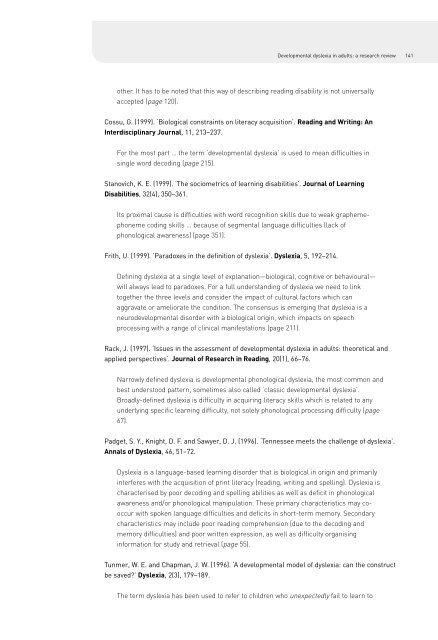01 NRDC Dyslexia 1-88 update - Texthelp
01 NRDC Dyslexia 1-88 update - Texthelp
01 NRDC Dyslexia 1-88 update - Texthelp
You also want an ePaper? Increase the reach of your titles
YUMPU automatically turns print PDFs into web optimized ePapers that Google loves.
Developmental dyslexia in adults: a research review 141<br />
other. It has to be noted that this way of describing reading disability is not universally<br />
accepted (page 120).<br />
Cossu, G. (1999). ‘Biological constraints on literacy acquisition’. Reading and Writing: An<br />
Interdisciplinary Journal, 11, 213–237.<br />
For the most part … the term ‘developmental dyslexia’ is used to mean difficulties in<br />
single word decoding (page 215).<br />
Stanovich, K. E. (1999). ‘The sociometrics of learning disabilities’. Journal of Learning<br />
Disabilities, 32(4), 350–361.<br />
Its proximal cause is difficulties with word recognition skills due to weak graphemephoneme<br />
coding skills … because of segmental language difficulties (lack of<br />
phonological awareness) (page 351).<br />
Frith, U. (1999). ‘Paradoxes in the definition of dyslexia’. <strong>Dyslexia</strong>, 5, 192–214.<br />
Defining dyslexia at a single level of explanation—biological, cognitive or behavioural—<br />
will always lead to paradoxes. For a full understanding of dyslexia we need to link<br />
together the three levels and consider the impact of cultural factors which can<br />
aggravate or ameliorate the condition. The consensus is emerging that dyslexia is a<br />
neurodevelopmental disorder with a biological origin, which impacts on speech<br />
processing with a range of clinical manifestations (page 211).<br />
Rack, J. (1997). ‘Issues in the assessment of developmental dyslexia in adults: theoretical and<br />
applied perspectives’. Journal of Research in Reading, 20(1), 66–76.<br />
Narrowly defined dyslexia is developmental phonological dyslexia, the most common and<br />
best understood pattern, sometimes also called ‘classic developmental dyslexia’.<br />
Broadly-defined dyslexia is difficulty in acquiring literacy skills which is related to any<br />
underlying specific learning difficulty, not solely phonological processing difficulty (page<br />
67).<br />
Padget, S. Y., Knight, D. F. and Sawyer, D. J. (1996). ‘Tennessee meets the challenge of dyslexia’.<br />
Annals of <strong>Dyslexia</strong>, 46, 51–72.<br />
<strong>Dyslexia</strong> is a language-based learning disorder that is biological in origin and primarily<br />
interferes with the acquisition of print literacy (reading, writing and spelling). <strong>Dyslexia</strong> is<br />
characterised by poor decoding and spelling abilities as well as deficit in phonological<br />
awareness and/or phonological manipulation. These primary characteristics may cooccur<br />
with spoken language difficulties and deficits in short-term memory. Secondary<br />
characteristics may include poor reading comprehension (due to the decoding and<br />
memory difficulties) and poor written expression, as well as difficulty organising<br />
information for study and retrieval (page 55).<br />
Tunmer, W. E. and Chapman, J. W. (1996). ‘A developmental model of dyslexia: can the construct<br />
be saved?’ <strong>Dyslexia</strong>, 2(3), 179–189.<br />
The term dyslexia has been used to refer to children who unexpectedly fail to learn to
















